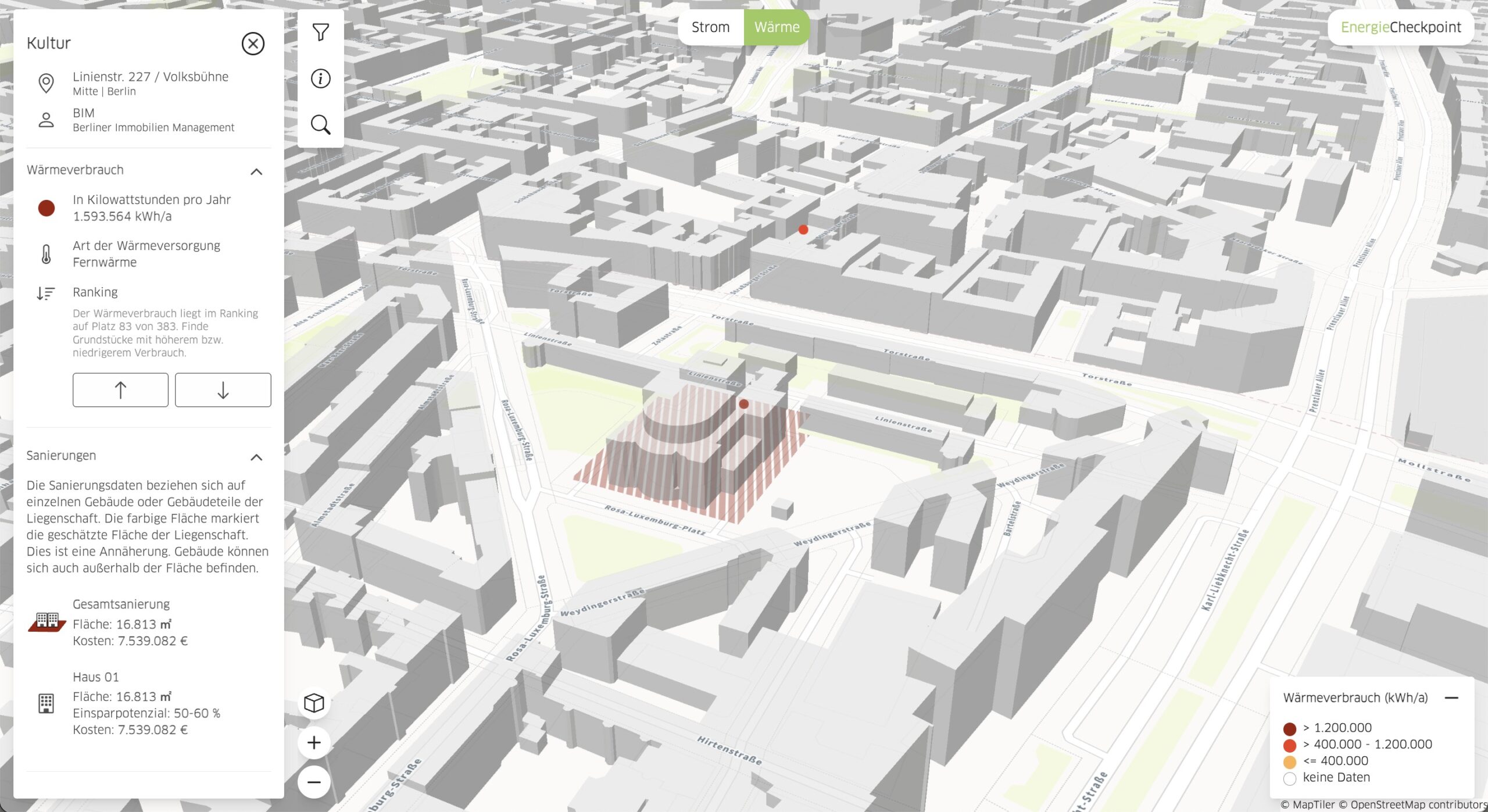Knowing how much energy a building consumes is a fundamental aspect of managing resources efficiently and curbing carbon footprints.
Just as important is knowing how much energy could be saved if a building is refurbished—as well as how much it might cost.
However, obtaining access to this data has been a challenge for many stakeholders. City planners and administrators, building owners and managers, environmental advocacy groups, researchers and academics, residents and consumers, businesses and investors, government agencies and regulators, nonprofits and community organisations all stand to benefit from greater transparency regarding a building’s energy usage.
In response to this challenge, open data projects like Berlin’s EnergieCheckpoint are helping to present such information in an actionable way.
What is the EnergieCheckpoint?
The EnergieCheckpoint is a prototype application that makes it possible to visualise data and explore individual buildings in Berlin. Users can view energy consumption by electricity and heat, the type of heat supply, and information on the savings potential of a building renovation. The data is displayed for all public buildings on a map.
For example, one can see how much heat and electricity the Volksbühne consumes, where it ranks among other public buildings (31 of 383), what it would cost to refurbish it (7,539,082 euros), and the energy savings potential (50-60 percent) of refurbishment. It even shows that the current energy consumption is equivalent to 242 homes with five people.
Data-driven decisions for more efficient energy use
Easily accessible data empowers stakeholders to make informed decisions regarding energy efficiency, refurbishments, and sustainable practices. The refurbishment roadmap, for example, serves the districts and BIM as a strategic instrument for refurbishment planning.
Furthermore, transparent data holds building owners and city authorities accountable for their environmental impact, encouraging responsible practices. It also enables researchers to develop innovative solutions and drive progress in energy efficiency.
As the City of Berlin has committed to climate neutrality by 2045, projects like EnergieCheckpoint are vital for identifying areas for improvement.
The power of open data
As the operator of public buildings, BIM Berliner Immobilienmanagement GmbH, like the boroughs, is obliged to report regularly and in full on energy consumption data and savings measures within the framework of the Berlin Climate Protection and Energy Turnaround Act (EWG Bln). EnergieCheckpoint’s application is based entirely on open data from BIM.
As the data is not yet available as machine-readable data on the Berlin data portal, it is considered “limited” open data. The current energy consumption overview is available for 2020, while the data for the refurbishment timetable is current as May 2022.
The EnergieCheckpoint is an open-source project and runs under an MIT licence. Accordingly, the idea as well as the source code can be used, adapted and further developed free of charge for implementation in other cities.
Getting citizens to strive for energy efficiency
In another project, the “Thermografiebefliegung” project in Münster, Germany, successfully used thermal imaging to assess the energy efficiency of rooftops and entire buildings. This data-driven initiative, which included over 25,000 downloads of thermal images and a tripling of energy consultations, exemplifies how open data and digitisation can empower property owners to identify and realise energy-saving opportunities.
The project’s success has also garnered interest from other communities, underlining the potential for data-driven solutions to drive sustainability efforts and save both energy and money.
Improvements through more sophisticated digital solutions
While the EnergieCheckpoint project in Berlin marks a significant leap toward data transparency, plenty of areas for improvement remain.
The data’s last update in 2020 raises questions about its relevance and applicability to the current energy landscape. Leveraging smart technology and the Internet of Things (IoT) to collect and analyse real-time data can enhance the accuracy and usefulness of the information.
Furthermore, increasing data accessibility by providing real-time or near-real-time information in machine-readable formats would empower stakeholders to engage in dynamic monitoring and analysis. More granularity can help make the data more actionable, with hourly or daily consumption patterns offering deeper insights.
Predictive analytics can play a role in forecasting energy consumption trends, assisting in more effective planning. Interactive tools that enable community members to explore the data, set goals, and track progress can foster community engagement in energy-saving initiatives.
Finally, combining the data with educational initiatives to raise awareness and encourage energy-efficient behavior among residents, building owners, and businesses can have a substantial impact.
Incorporating these enhancements will not only bolster the EnergieCheckpoint project but also be instrumental in realising the calculated energy-saving potential of refurbishments.
The post EnergieCheckpoint: Visualising the Energy Efficiency of Berlin’s Public Buildings appeared first on Digital for Good | RESET.ORG.


